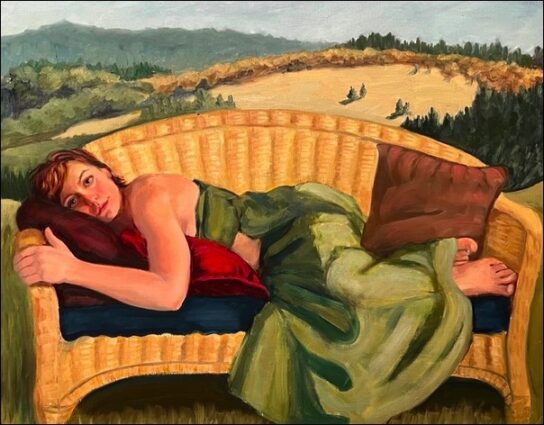“Back to the garden”:
Artwork by Mendocino County back-to-landers subject of new exhibit

Article by Roberta Werdinger
On May 19, from 5 to 7:30 p.m., the Grace Hudson Museum will hold an opening reception for its new exhibit, Something’s Happening Here: Artistic Reflections on the Back to the Land Movement. Refreshments will be served, and Will Siegel and Friends with Les Boek, Steve Baird, and Ellie Siegel will play music. Featuring artwork in diverse mediums by 35 Mendocino County residents who migrated here as part of the movement, the exhibit showcases the enormous creativity expressed by each individual in a time when “do your own thing” was a popular slogan, as well as their profound collective impact on the culture, beliefs, and lifestyles of Mendocino County at large. The reception is free and open to the public.
The late 1960s and early 1970s were a time of turmoil and rapid change. Martin Luther King, Jr. and Robert Kennedy were both assassinated in 1968, provoking uprisings. Inner cities erupted in violence in what some people called “race riots” and others saw as collective uprisings against police killings of Black people. The Vietnam War was still raging; young men would gather to burn their draft cards, with demonstrations and anti-war sentiments fueling strong expressions.
The Baby Boomers, born between 1946 and 1964, were the largest generation yet to exist in America. Buoyed by the power of numbers, they were able to express a distinct ethic that was at times confrontational and radical, and yet also carried a message of peace, love, and freedom. Rebelling against their elders, who had been formed by the hardships of the Great Depression of the 1930s and World War II, the Boomers rejected what they saw as empty values of materialism. Having been raised in a prosperous era, they set their sights not on material success but on transcendental breakthrough. Some took psychedelic drugs; others practiced meditation and explored Asian religions. Either way, they set out to remake culture, wedding their own visions and ideas to new iterations of traditional ways.
Many young people had migrated to California, and especially to San Francisco’s Haight-Ashbury neighborhood, at the heyday of the psychedelic era. When the Haight’s scene collapsed after the Summer of Love of 1967, many began leaving the city to form communes and find places where they could put their values into play. They wanted to grow their own food, build their own houses, live simply, and raise their families away from the corrupting influences of modern and urban civilization.
What better place could they find than Mendocino County? It was beautiful; it was not far from San Francisco; the weather was relatively mild; and land was cheap and plentiful. The residents of the county, however, were not so sure about the advent of the newcomers. The locals tended to be blue-collar and conservative, while the back-to-landers were largely white (as were the locals), college-educated and middle-class. The long hairstyles on men, marijuana smoking and growing, and anti-establishment values didn’t go over so well, especially with the older generation who had fought and lost loved ones in World War II. However, differences between locals and newcomers rubbed away with time. Many of the back-to-landers were hardworking and had a DIY (“do it yourself”) ethos which fit in well with the locals, some of whom had originated from homesteaders who lived off the land. While most communes didn’t last, many former inhabitants moved into the inland or coastal towns, and ended up forming important community institutions which are still alive today: Ukiah Players Theatre, SPACE, the Ukiah Co-op, Willits Community Theatre, and more. They were joined by other back-to-landers who hadn’t lived on communes and who had moved into town for different reasons: some had jobs there, while others had grown tired of the isolation or rigors of country life.
When Alyssa Boge, Grace Hudson Museum Curator, and David Burton, the Museum’s Director, set out to visit and interview Mendocino County artists and craftspeople who had been back-to-landers in order to form this exhibit, they saw a collection of individuals, not people who had signed up for a movement. “I was surprised at how non-homogeneous they were,” Boge says. While they all shared a value of living simply and close to nature, their other choices could differ widely. Some believed in living communally; others were fierce individualists. Some used psychedelics and grew marijuana; others wouldn’t go near the stuff. Some engaged in political protest, including actions against clearcutting of redwood forests; others preferred to go within and shift consciousness. What they all had in common, though, was the creativity that suffused their daily lives. Burton notes that the very act of choosing to go back to the land was a creative one. Traditional crafts, such as weaving and woodworking, were revived and renewed. Thus the exhibit includes a plethora of mediums: furniture, clothing, instruments, masks, watercolors, mixed media, posters, and pottery.
“Every single back-to-lander we met was creative in one way or another,” Burton says. It was not so much art for art’s sake, as that a person had to be creative if they were to live out on the land. Anyone trying to install a water system or raise a herd of goats had to learn how to do it or figure out how to jury-rig a solution. Self-reliance is a close cousin of creativity. “If they practiced or never practiced any of the fine arts, their life on the land was itself a work of art,” Burton concludes.
Something’s Happening Here: Artistic Reflections on the Back to the Land Movement will be on display until Oct. 15, 2023. Several events, including a summer solstice celebration and a back-to-the-land artists panel, are planned.
The Grace Hudson Museum is at 431 S. Main St. in Ukiah. The Museum is open Wednesday through Saturday from 10 a.m. to 4:30 p.m., and Sunday from noon to 4:30 p.m. For more information please go to www.gracehudsonmuseum.org or call (707) 467-2836.